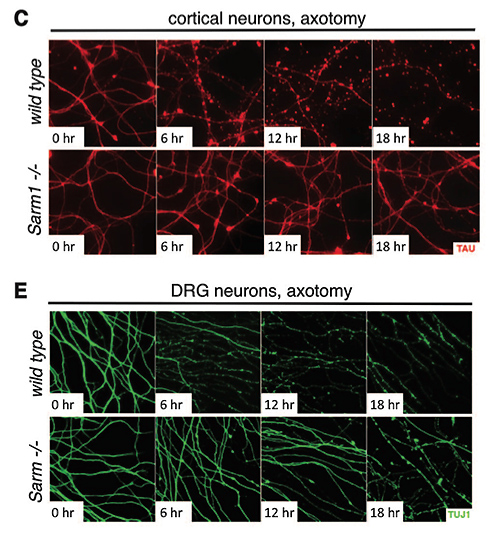- 2012年度
- 大脳皮質の進化の謎に迫る
(2013/03/29) - 活性型ビタミンDで小胞体ストレスを緩和しよう!
(2013/03/29) - Sweat Glands Grown from Newly Identified Stem Cells
(2013/03/29) - ~筋肉の恒常性と健康は相反するものなのか?~ 筋肉においてオートファジーが存在するが故にインスリン抵抗性が存在する
(2013/03/29) - たった1つの因子の抑制で様々な細胞が神経に!?
(2013/03/28) - 乳酸菌を取り込むと、細胞も若返る?! ~"人間、またしても発酵食品のお世話になる"の巻~
(2013/03/27) - 脳腫瘍における新しい遺伝子変異~エピジェネティク
(2013/03/27) - CCR2-dependentrecruitment of macrophages by tumor-educated mesenchymal stromal cells promotes tumor development and is mimicked by TNFα
(2013/03/25) - 補体C1qはWntシグナルの活性化を介して細胞を老化させる
(2013/03/19) - Speramtogonial Stem Cell Transplantation into Rhesus Testes Regenerates Spermatogenesis Producing Functional Sperm.
(2013/03/12) - 糖尿病薬剤による抗腫瘍効果
(2013/03/12) - 難病ALSの新たな原因遺伝子の発見
(2013/03/12) - 脊髄損傷にヒートショックプロテインが有効?
(2013/03/11) - 片頭痛患者では血管内皮前駆細胞が少ない?
(2013/03/11) - 筋幹細胞の静止状態はmiRNA-489により維持される
(2013/03/11) - ストレスに弱いってどういうこと?(心の病気にかかるメカニズムの一つ、「ストレス脆弱モデル」をネズミで再現)
(2013/03/09) - 核酸医薬は実現するか~筋強直性ジストロフィー治療の可能性~
(2013/03/09) - なくならないのは技がある!
(2013/03/08) - Down症候群のiPS細胞の染色体数を修正する
(2013/03/08) - 高品質なiPS細胞作製のキーファクターZscan4の同定
(2013/03/08) - Turning off the Neuron Death Pathway
(2013/03/07) - 新しい安全な分子標識-マルチ同位体画像質量分析法-が明らかにした幹細胞の不等分裂様式
(2013/03/07) - 重度脊髄損傷後に移植した神経幹細胞が非常に長く軸索を伸長し、シナプス結合した!
(2013/03/07) - 神経系前駆細胞を元気にして水頭症を治す!?
(2013/03/05) - FUS/TLSとTDP-43 二つのALS原因遺伝子の交差点
(2013/03/01) - 貪食細胞マクロファージが造血幹細胞を優しく包み込んで自己複製能の維持に貢献していた!?
(2013/02/27) - TALENs -新遺伝子改変技術が生命科学を変える!?-
(2013/02/27) - RESTタンパク質による遺伝子発現調節 ~遺伝子発現とシナプス機能~
(2013/02/25) - 腸に住んでいるある平凡な細菌によって大腸がんは引き起こされる!
(2013/02/25) - 癌抑制遺伝子p53の変異はメバロン酸経路を活性化することで、正常な乳腺の構造を失わせる
(2013/02/25) - 樹状細胞は制御性T細胞の恒常性をコントロールすることで多発性硬化症を寛解させる
(2013/02/25) - Schwann Cell Plasticity After Spinal Cord Injury Shown by Neural Crest Lineage Tracing
(2013/02/15) - エクソソームは、癌細胞の「飛び道具」!
(2013/02/08) - 老化したニッチでは筋肉幹細胞は静止状態を保てない
(2013/01/31) - 幹細胞を使った創薬開発
(2013/01/31) - 体細胞リプログラミングにおける遺伝子発現調節の解析からわかること-single cellで見てみようの巻-
(2013/01/31) - がん幹細胞発生のかぎを握るのは誰?-ユーイング肉腫がん幹細胞の解析を通じた検証-
(2013/01/31) - 小動物用PET(Positron Emission Tomography)で、ラットの脳梗塞巣を探知することができる [18F]BMS-PET
(2013/01/31) - 脳の神経ネットワークにおけるヤングパワー!
(2013/01/18) - アストロサイトの性格はどうやって決まる?
(2013/01/18) - 幹細胞の自己複製能を制御する因子とは?
(2013/01/18) - アルデヒドが真犯人!?DNA損傷と再生不良性貧血
(2012/12/18) - HIV-2の新しい定量法
(2012/12/18) - Japanese People's Preference for Place of End-of-Life Care and Death: A Population-Based Nationwide Survey
(2012/12/18) - がん細胞の死に際
(2012/12/18) - 癌幹細胞を眠りから目覚めさせる"Coco"
(2012/12/13) - 細胞接着分子のインテグリンが血液の幹細胞の維持を制御する
(2012/12/11) - 移植された神経幹細胞は免疫系にも作用する
(2012/12/11) - 血液がん克服にむけて!~JAK2阻害剤の薬剤耐性メカニズム解明~
(2012/12/04) - 癌進展を陰で操る支配者
(2012/11/30) - 幹細胞の2つの顔を暴け!!! 未分化性維持と特異的分化との狭間で...
(2012/11/30) - 脊髄損傷後の機能回復には自発的なリハビリが効果的
(2012/11/21) - もしあなたの歯が無くなってしまった時に...
(2012/11/15) - iPS細胞から血小板をつくる
(2012/10/30) - メラノーマのエキソソームで予後予測ができる?!
(2012/10/30) - Oligodendroglia Cells Can Do Much More Than an Insulator for Neuron
(2012/09/11) - APJは、心臓肥大のデュアル受容体として作用する
(2012/09/11) - 幹細胞医療;脳梗塞治療への挑戦
(2012/09/11) - 造血幹細胞の老化と若返り
(2012/09/11) - カロリー制限が筋肉を増やす? - トレーニング界の常識に挑戦する新たな"逆説"
(2012/09/11) - 癌幹細胞は治療標的にならない!?
(2012/08/24) - iPS細胞でC型肝炎ウイルス感染のモデルをつくる
(2012/08/09) - ES細胞、iPS細胞から内耳有毛細胞への分化誘導
(2012/08/09) - 造血幹細胞を冬眠させる細胞はなんと神経系の細胞だった!
(2012/07/06) - 個別化治療への障壁 ~多重人格なガンを克服せよ~
(2012/07/06) - 栄養のバランスが新しいニューロンを作り、体重や新陳代謝をコントロールする
(2012/05/11) - 脊髄不全損傷後におこる、残存神経ネットワークの代償機能
(2012/05/11) - "スーパーPTENマウス"
(2012/04/20) - 統合失調症iPS細胞研究が臨床研究になるために
(2012/04/20) - 発癌機序における"はじめの一歩"
(2012/04/06) - iPS細胞は脊髄損傷を治せるのか?
(2012/04/06)
- 大脳皮質の進化の謎に迫る
- 2011年度
- 2010年度
ホーム > 世界の幹細胞(関連)論文紹介 > Turning off the Neuron Death Pathwa...
Turning off the Neuron Death Pathway
論文紹介著者

Daniela Yumi Kitashima(博士課程 3年)
GCOE RA
皮膚科学教室
第一著者名・掲載雑誌・号・掲載年月
Jeannette M. Osterloh/Science 337, 481 (2012)
文献の英文表記:著者名・論文の表題・雑誌名・巻・号・ページ・発行年(西暦)
Jeannette M. Osterloh, Jing Yang, Timothy M. Rooney, A. Nicole Fox, Robert Adalbert, Eric H. Powell, Amy E. Sheehan, Michelle A. Avery, Rachel Hackett, Mary A. Logan, Jennifer M. MacDonald, Jennifer S. Ziegenfuss, Stefan Milde, Ying-Ju Hou, Carl Nathan, Aihao Ding, Robert H. Brown Jr., Laura Conforti, Michael Coleman, Marc Tessier-Lavigne, Stephan Zuchner and Marc R. Freeman. dSarm/Sarm1 Is Required for Activation of an Injury-Induced Axon Death Pathway. Science. 337 481-484, 2012
論文解説
When axons are severed in the context of peripheral neuropathy, brain injury or neurodegenerative disease, the portion of the axon distal to the injury site undergoes extensive fragmentation. The mechanism that drives this process, termed Wallerian degeneration, is not understood. Traditionally it was thought to result from passive process due to a lack of cell body-derived nutrients, however recently it has been speculated that Wallerian degeneration might be an active process that axons promote their own destruction after injury. The authors confirmed the last hypothesis and additionally identify a functional key gene of this pathway.
In experiments with flies, the authors found that a few axons remained fully intact after injury in mutant flies. From genetic study of these mutant flies, they identified a single gene affected in all: dSarm (Drosophila sterile alpha and Armadillo motif.). In other words, the reason why those mutant axons did not generate upon injury was a loss of function of dSarm, indicating that its function is necessary in neurons to drive axonal destruction after injury.
Next, they assessed Walleriam degeneration in mice that lack the correspondent in mammalians of dSarm, Sarm1. As expected in vitro experiments showed that neurons deficient in Sarm1 exhibited robust protection from degeneration compared with wild type (normal) neurons (Fig1.). Interestingly, these mutant neurons were not protected from other types of damages such as nerve growth factor deprivation, suggesting that Sarm1 protection is specific to injury-induced axon degeneration. To determine whether Sarm1 is required for Walleriam degeneration in vivo, they evaluated a sciatic nerve injury mouse model. The results showed that mice deficient of Sarm1 axons were protected from degeneration.

Fig1. (C) Axon preservation at the indicated time points in cortical neuron cultures from mouse embryos. (E) Axon preservation at the indicated time points in dorsal root ganglia cultures from E13.5 mouse embryos.
This research of dSarm/Sarm1 provides evidence that Walleriam degeneration is driven by an ancient, conserved axonal death program. The specific axon injury induces the activation of dSarm/Sarm1 that trigger an autodestruct program and consequently axon degeneration. Although the precise mechanism of this cascade remains unknown, this study opens doors for a new approach to the advantage of deletion of Sarm1 in animal models of neurodegenerative disease. Moreover, Sarm1 could be a promising therapeutic target in humans. Pharmacological inhibition of Sarm1 may provide benefits to patients with axonal loss and therefore may be a new treatment for peripheral neuropathy, brain injury of neurodegenerative disease
Copyright © Keio University. All rights reserved.
